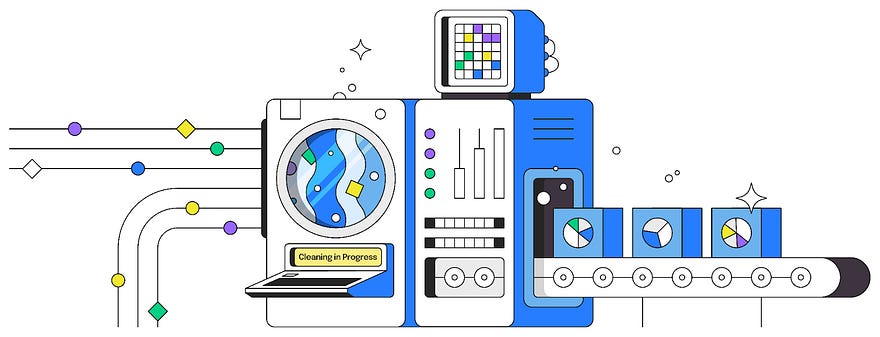A Beginner-to-Upper Intermediate Data Science Roadmap for 2025 #7: Data Cleaning & Preprocessing
A Step-by-Step Roadmap to Start a Data Science Career In 2025
In the Seventh article of the series A Beginner-to-Upper Intermediate Data Science Roadmap for 2025, you will learn the fundamentals of Data Cleaning & Preprocessing for data science.
Data cleaning and preprocessing are one of the most important parts of a data scientist’s day. It’s something you’ll do on a daily basis. Being able to clean your data effectively effectively will result in better results with less effort.
I believe that the more you know, the better you will understand the data, which will help you to produce better results and be effective at work. There are many courses and books on this topic that you can read to expand your knowledge and skills. I went through most of them and selected the most important ones that will build your fundamentals.
This article is the Seventh article in the ongoing series of A Beginner-to-Upper Intermediate Data Science Roadmap for 2025:
Introduction to Data Science & Data Methodology (Published!)
Data Cleaning & Preprocessing (You are here!)
Feature Engineering (Coming Soon!)
Mastering Machine Learning (Coming Soon!)
Deep Learning Fundamentals (Coming Soon!)
Generative AI & Large Language Models (LLMs) Fundamentals (Coming Soon!)
Machine Learning Operations (MLOps) (Coming Soon!)
Building Your Data Science Portfolio (Coming Soon!)
Getting Ready for the Market (Coming Soon!)
Whether you’re a recent graduate or a professional looking to make a career change, the field of Data Science and AI offers a wide range of exciting and lucrative opportunities.
In this series of articles, I will provide you with a comprehensive guide that provides a clear and actionable plan for building the skills and knowledge you need to succeed in this growing field. By following the steps outlined in this roadmap, you’ll be well on your way to a successful and rewarding career in Data Science and AI.
This roadmap will take you to an upper intermediate level, and you can land a job and start your career after finishing it. However, to go to an advanced level, you will need to take more in-depth courses, books, and research papers.
For each learning step, there will be compulsory material, optional material, and action points to ensure that you implement what you have learned. Also, each of the learning resources will be estimated in hours, so you can calculate the time needed to finish this roadmap based on your pace.
Table of contents:
Data Exploration Learning Resources
Data Cleaning & Data Preprocessing Learning Resources
Optional Learning Resources
Putting it into Action
My New E-Book: Efficient Python for Data Scientists
I am happy to announce publishing my new E-book Efficient Python for Data Scientists. Efficient Python for Data Scientists is your practical companion to mastering the art of writing clean, optimized, and high-performing Python code for data science. In this book, you'll explore actionable insights and strategies to transform your Python workflows, streamline data analysis, and maximize the potential of libraries like Pandas.
1. Data Exploration
So you’ve got some interesting data—where do you begin your analysis? This learning step covers the process of exploring and analyzing data, from understanding what a dataset includes to incorporating exploration findings into a data science workflow.
By the end of this learning step, you’ll have the confidence to perform your own exploratory data analysis (EDA) in Python. You’ll be able to explain your findings visually to others and suggest the next steps for gathering insights from your data!
Learning Resources:
Introduction to Statistics in Python | Expected Duration (2 days) | Datacamp
Introduction to Data Visualization with Seaborn | Expected Duration (2 days) | Datacamp
Exploratory Data Analysis in Python Expected Duration (2 days) | Datacamp
2. Data Cleaning & Data Preprocessing
Data cleaning is a key part of data science, but it can be deeply frustrating. Why are some of your text fields garbled? What should you do about those missing values? Why aren’t your dates formatted correctly? How can you quickly clean up inconsistent data entry? In this course, you’ll learn why you’ve run into these problems and, more importantly, how to fix them!
In this learning step, you’ll learn how to tackle some of the most common data-cleaning problems so you can analyze your data faster. You’ll work through five hands-on exercises with real, messy data and answer some of your most commonly-asked data cleaning questions.
Keep reading with a 7-day free trial
Subscribe to To Data & Beyond to keep reading this post and get 7 days of free access to the full post archives.







